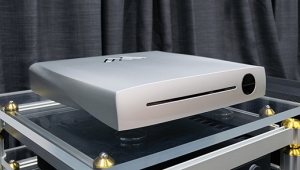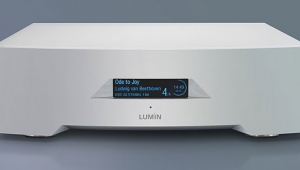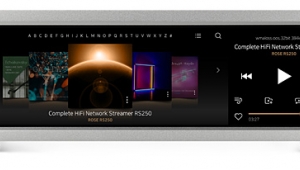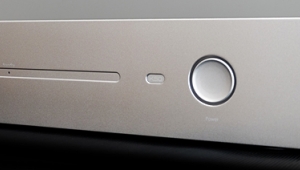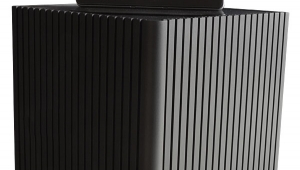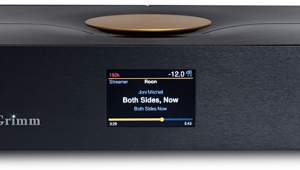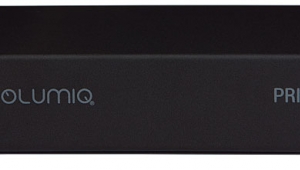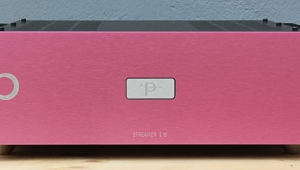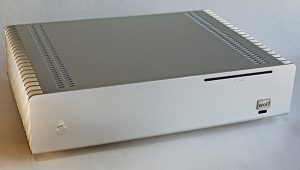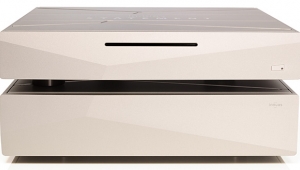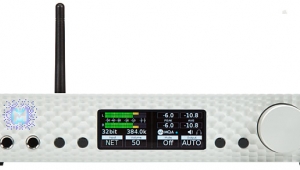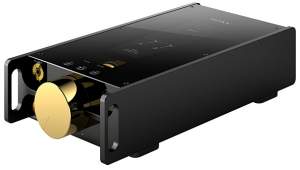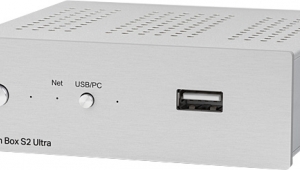| Columns Retired Columns & Blogs |
T+A Music Player Media Streamer Measurements
Sidebar 3: Measurements
I examined the T+A Music Player's performance primarily using the Audio Precision SYS2722 system (see www.ap.com and "As We See It" in the January 2008 issue), as well as, for some tests, our vintage Audio Precision System One. I used my regular CD-R of 16-bit test tones, and also fed data to the Music Player's optical digital input. I also used some test WAV files stored on a USB flash drive, and fed the MP files over my WiFi network using Windows Media Player 11 as the uPnP client, running on a PC with Windows XP SP3. (For some arcane networking reason, neither of my Macs would recognize the MP.)
The Music Player's maximum output was 2.4V RMS, or 1.6dB higher than the CD standard's 2V; this was the same with its output set to Fixed volume, or set to Variable with the volume control set to its maximum. The output preserved absolute polarity with the MP set to Normal, and was inverted, as expected, when the MP was set to Inverted. The output impedance was usefully very low at 22 ohms across the audioband. Used as a CD player, the T+A's error correction was good rather than great, the MP producing audible glitches and flagging errors in the output data while playing track 30 of the Pierre Verany Test CD, whose data spiral includes 0.75mm gaps.
The T+A Music Player will correctly lock on to and decode datastreams sampled at 88.2 and 96kHz that are fed to its two S/PDIF inputs, but the display stubbornly shows "44.1kHz." The MP has two settings that affect its frequency response: Filter and Bandwidth. Fig.1 shows the response with the Filter set to "Filter 2" and the Bandwidth set to "Wide," with both CD data at 44.1kHz (blue, magenta traces) and external 96kHz-sampled PCM data (blue, red). This Filter optimizes the time-domain performance at the expense of a droop in the top octave, which reaches –3dB at 20kHz with CD data. This graph was taken into the high 100k ohm laboratory load impedance; the behavior was not affected by dropping the load to the punishing 600 ohms. Fig.2 shows the responses with the Filter set to "Filter 1" and Bandwidth to "Wide." CD playback is now flat almost to 20kHz, with the 96kHz behavior smoothly continuing the slight rolloff to reach –0.5dB at 40kHz.

Fig.1 T+A Music Player, Filter 2, Wide frequency response at –12dBFS into 100k ohms with external data at 44.1kHz (left channel cyan, right magenta) and 96kHz (left blue, right red). (1dB/vertical div.)

Fig.2 T+A Music Player, Filter 2, frequency response at –12dBFS into 100k ohms with external data at 44.1kHz (left channel cyan, right magenta) and 96kHz (left blue, right red). (1dB/vertical div.)
Plotted on an expanded scale for clarity, fig.3 shows the effect of the Bandwidth control. Set to Wide (blue, red traces), the output is down just 0.12dB at 20kHz and –0.75dB at 45kHz. Set to Normal (cyan, magenta), the audioband output actually rises by 0.1dB, with the response –0.35dB at 20kHz and –2.35dB at 45kHz. The response error with preemphasized CDs was nonexistent, so I haven't shown it. Channel separation (fig.4) was superb, at >120dB below 20kHz and still 105dB at 20kHz.

Fig.3 T+A Music Player, Filter 1, frequency response at –12dBFS into 100k ohms with external data at 96kHz with Normal bandwidth (left channel cyan, right magenta) and Wide bandwidth (left blue, right red). (0.25dB/vertical div.)

Fig.4 T+A Music Player, channel separation (5dB/vertical div.).
For reasons of continuity with my published reviews of digital components, my first examination of resolution is performed by sweeping a 1/3-octave bandpass filter down from 20kHz to 20Hz while playing a dithered 1kHz tone at –90dBFS. The result of this test with the MP playing CD data is shown as the top pair of traces in fig.5. The left- and right-channel traces peak at exactly –90dBFS, implying very low linearity error, while the gently sloping noise floor is free from harmonic and power-supply spuriae, and actually just shows the spectrum of the dither recorded on the test CD-R. Changing to dithered 24-bit data fed to the MP's optical S/PDIF input gave the middle pair of traces in fig.5. The noise floor has dropped by around 16dB, implying resolution close to 19 bits, which is excellent; again, no spuriae can be seen. The MP's digital and analog sections are obviously well engineered. Dropping the external signal level to –120dBFS, which is beyond the capabilities of CD, gave the bottom pair of traces, which show the tone clearly resolved by the MP.
Fig.6 shows FFT-derived spectra for 16-bit (cyan, magenta traces) and 24-bit data (blue, red). Some very-low-level harmonic spuriae can now be seen with the hi-rez data, but these are well below the CD data's noise floor. However, the wide bandwidth and excellent resolution of the Music Player's D/A section is available only via the S/PDIF digital inputs. Files with sample rates higher than 48kHz on the network or a USB drive were not recognized by the MP, and while it would play 24-bit files with 44.1 or 48kHz sample rates, it truncated these to 16 bits. This is graphically illustrated in fig.7, which shows 1/3-octave spectra of the MP's output while it decoded, from a USB drive, a 1kHz tone at –90dBFS with dithered 16-bit data (top pair of traces) and dithered 24-bit data (bottom traces). The 16-bit spectrum is the same as that shown in fig.4; due to the truncation (confirmed by FFT analysis, fig.8), the 24-bit traces have peaks present at the odd harmonics of the 1kHz tone.
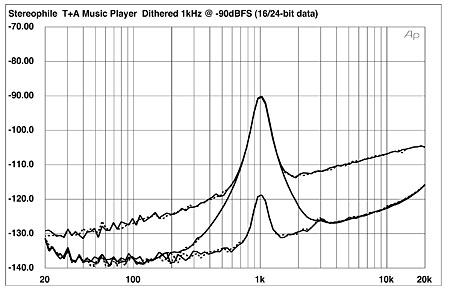
Fig.5 T+A Music Player, 1/3-octave spectrum with noise and spuriae of dithered 1kHz tone at –90dBFS with 16-bit CD data (top), 24-bit external data (middle at 2kHz), and of dithered 1kHz tone at –120dBFS with 24-bit external data (bottom at 1kHz). (Right channel dashed.)

Fig.6 T+A Music Player, FFT-derived spectrum with noise and spuriae of dithered 1kHz tone at –90dBFS with 16-bit CD data (left channel cyan, right magenta) and 24-bit external data (left blue, right red).
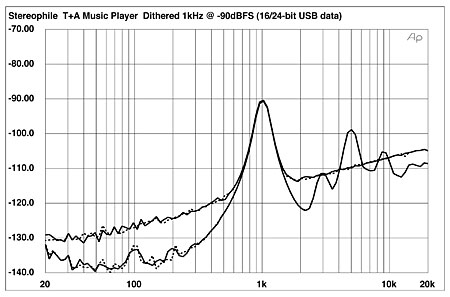
Fig.7 T+A Music Player, 1/3-octave spectrum with noise and spuriae of dithered 1kHz tone at –90dBFS with 16-bit CD data (top) and 24-bit USB data (bottom). (Right channel dashed.)

Fig.8 T+A Music Player, FFT-derived spectrum with noise and spuriae of dithered 1kHz tone at –90dBFS with 24-bit USB data (left blue, right red).
As anticipated from fig.5, plotting the 16-bit linearity error against absolute level really revealed only the effect of the recorded dither, so I haven't shown that graph. With its low noise and excellent linearity, the Music Player's reproduction of an undithered tone at exactly –90.31dBFS (fig.9) was essentially perfect, while undithered, external 24-bit data gave a very clean-looking sinewave (fig.10).

Fig.9 T+A Music Player, Filter 1, waveform of undithered 1kHz sinewave at –90.31dBFS, CD data (left channel blue, right red).

Fig.10 T+A Music Player, Filter 1, waveform of undithered 1kHz sinewave at –90.31dBFS, 24-bit external data (left channel blue, right red).
The Music Player's analog output section offered superbly low distortion. Even into 600 ohms, the harmonic spuriae all lay at or below –110dB, or 0.0003% (fig.11). It was only on the very demanding high-frequency intermodulation tests that the MP stumbled a little, and then only when set to Filter 1. While actual intermodulation products from the high-level 19 and 20kHz tones are very low in level, the audioband noise floor is muddied by what I must assume are mathematical artifacts from the digital low-pass filter (fig.12). Changing to what Jon Iverson felt was the better-sounding Filter 2 gave a much cleaner audioband spectrum (fig.13), though the tradeoff is some image leakage of the primary tones, which can be seen at 25.1 and 24.1kHz. But again, actual intermodulation is vanishingly low.

Fig.11 T+A Music Player, spectrum of 1kHz sinewave at 0dBFS into 600 ohms, 24-bit external data (left channel blue, right red; linear frequency scale).

Fig.12 T+A Music Player, Filter 1, HF intermodulation spectrum, 19+20kHz at 0dBFS peak into 100k ohms, 24-bit external data (left channel blue, right red; linear frequency scale).

Fig.13 T+A Music Player, Filter 2, HF intermodulation spectrum, 19+20kHz at 0dBFS peak into 100k ohms, 24-bit external data (left channel blue, right red; linear frequency scale).
Finally, I tested the Music Player's susceptibility to clock jitter, both by playing the 16-bit Miller/Dunn J-Test signal on CD, and by feeding it from a PC soundcard's digital output via 15' of plastic TosLink to one of the MP's digital inputs. The results were the same: the harmonics of the low-frequency squarewave were almost all at the residual level, and were in the main not being accentuated by the T+A's digital section (fig.14); and the central spectral peak representing the tone at one-quarter the sample rate was very cleanly defined.

Fig.14 T+A Music Player, high-resolution jitter spectrum of analog output signal, 11.025kHz at –6dBFS, sampled at 44.1kHz with LSB toggled at 229Hz, CD data. Center frequency of trace, 11.025kHz; frequency range, ±3.5kHz (left channel blue, right red).
Its measured performance indicates that the T+A elektroakustik Music Player is a superbly well-engineered and extremely versatile media player.—John Atkinson
- Log in or register to post comments
